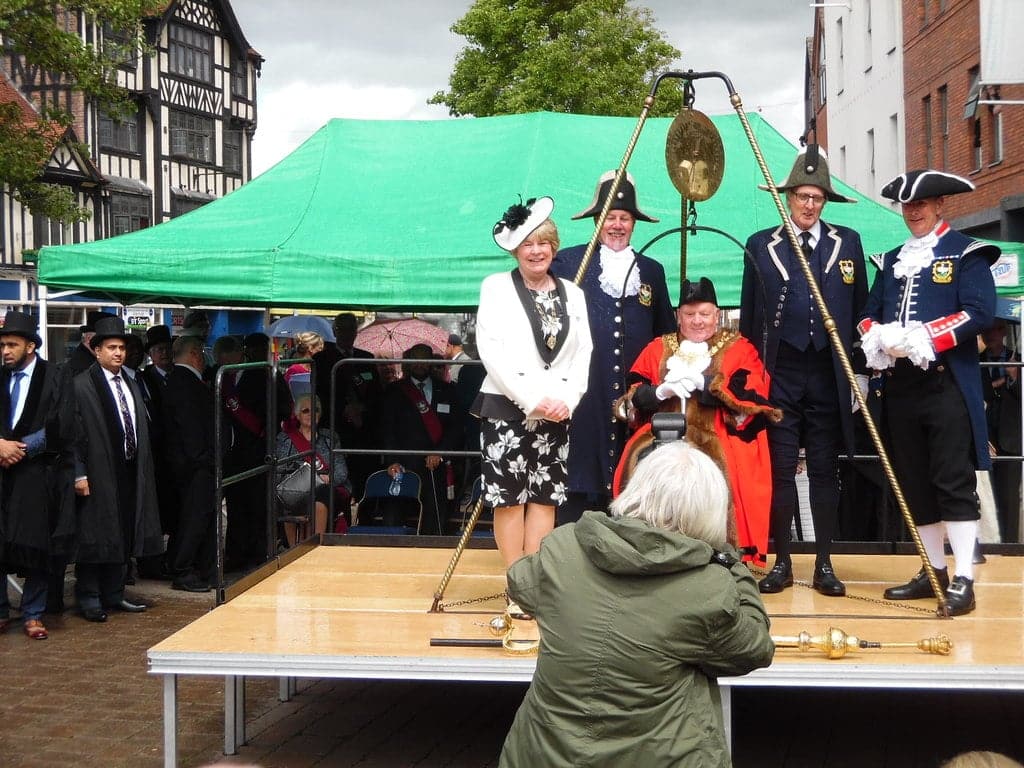Last Updated on 12/03/2023 by Alex Hamlyn
Table of Contents
Where is High Wycombe?
Weighing the Mayor
There is a tradition in High Wycombe known as “weighing the mayor,” which dates back several centuries. The tradition involves weighing the newly elected Mayor on a scale, using a weighing machine known as a “weighing chair.”
The weighing ceremony takes place in public, usually in the town’s historic Guildhall, and is attended by local dignitaries, members of the public, and other officials. The Mayor sits in the weighing chair while a group of local people, known as “weighers,” use a set of scales to determine the Mayor’s weight.
The tradition of “weighing the mayor” in High Wycombe, UK, is believed to date back several centuries, to the 1670s. It is thought that the tradition may have started in the medieval period, and some sources suggest that it may have been used as a way of demonstrating the Mayor’s wealth and status.
Watch the town weighing the Mayor of High Wycombe in 2022
Why did the town start weighing the Mayor of High Wycombe?
We know two stories that tell of the reasons for this strange tradition, but they are nothing alike. Which one do you think sounds more likely?
Version 1
In the first, the tradition is said to have originated as a way to ensure that the new Mayor was fit and healthy enough to carry out their duties. In the past, being overweight was seen as a sign of wealth and prosperity, and the weighing ceremony was also used to demonstrate the Mayor’s social status.
Version 2
In the second, (and frankly the more interesting and plausible explanation) the weighing chair was a tool used to measure corruption. By weighing the mayor, the townsfolk could see if he was getting too fat on the back of the taxpayer.
The mayor’s weight would be recorded at the start of his term, and after one year he would be weighed again. If the Macebearer – the individual appointed to report the results of the mayor’s weighing – calls out “And no more!”, it means the mayor has not gained any weight.
If instead he calls out the weight “And some more!” it means the mayor has been living well – too well – off the back of the taxes paid by the common folk. Jeers and assaults with rotten fruit would likely follow from the crowd.
Apparently, in this second version, it was Queen Elizabeth herself that ordered the first weighing!

When did the weighing of the Mayor of High Wycombe start?
The earliest recorded mention of the weighing ceremony in High Wycombe is from the 1670s, in a book by the historian and antiquary Anthony Wood, who described the ceremony as “the custom of weighing the Mayor, who is to pay so much for his weight, which is more or less according to his fatness or leanness.”
Anthony Wood (1632-1695) was an English antiquary and historian who is best known for his works on the history of the University of Oxford. He was born in Oxford, England, and was educated at the university, where he developed a passion for history and antiquities. He also wrote extensively on other topics, including the history of the English Civil War, local history, and topography.
Since then, the tradition has continued to be observed in High Wycombe, and it is now a well-established part of the town’s cultural heritage. Although the significance and purpose of the weighing ceremony have changed over time, it remains a popular and unique tradition that is closely associated with the town’s history and identity.
Today, the weighing ceremony is largely symbolic, and the Mayor’s weight is not taken seriously as an indicator of their fitness or suitability for the role. However, the tradition is still observed as a way to connect the present-day Mayor with the town’s rich history and traditions.
What about the chair in which the Mayor was weighed?
The “weighing chair” used in the tradition of “weighing the mayor” in High Wycombe is a large, ornate wooden chair that is designed to accommodate the Mayor and the set of scales that are used to weigh them.
The chair is typically made of oak, which was a common material for furniture in the medieval period, and it is often decorated with intricate carvings and other decorative features. The seat of the chair contains a set of scales that are built into the design, and which are used to determine the weight of the Mayor.
The design of the weighing chair has evolved over time, and different versions of the chair may have had slightly different features or decorations. However, the basic concept of a large wooden chair with a built-in set of scales has remained the same, and the weighing chair is an important part of the tradition of “weighing the mayor” in High Wycombe.
Today, the original weighing chair is on display at the Wycombe Museum, where it can be viewed by members of the public who are interested in the history of High Wycombe and its traditions.
See the town weighing the Mayor of High Wycombe in 1938
Can I be weighed in the chair?
You’re probably not going to be allowed to actually sit on the chair, so we can’t be sure if you are qualified to be mayor. However, as the chair is an important historical artefact, it is likely that it is only for display purposes and that sitting on it may not be allowed.
If you are interested in a political career then when you visit the Wycombe Museum, we recommended that you contact the museum directly to inquire about their policies and procedures for sitting in the chair.
On the website, you can find more information about the museum, its exhibits, and its opening hours.
You can also contact the museum directly if you have any questions about visiting or the display of the weighing chair.
Did other towns weigh their Mayor?
There are other towns in the UK that have similar traditions of “weighing the mayor” or other officials. For example, the town of Stamford in Lincolnshire has a similar tradition known as “the Bull Running,” which involves a live bull being led through the streets, and the newly elected Mayor being weighed on a set of scales.
Another town with a similar tradition is Llangefni in Wales, where the newly elected Mayor is weighed in public using a traditional weighing machine. The tradition in Llangefni dates back to the 17th century and is said to have originated as a way to ensure that the Mayor was not overindulging in food and drink (which supports the corruption theory detailed above).
The tradition of “weighing the mayor” or other officials is believed to have been more widespread in the past, and many other towns and cities may have had similar traditions that have since fallen out of use.
Today (sadly), the practice is largely viewed as a symbolic way to celebrate a town’s history and traditions, rather than a serious measure of an official’s fitness or suitability for their role.
Do mayors get weighed (or similar) in other places around the world?
There are similar traditions from around the world where the weight of a person or object is used as a symbolic measure of their importance or significance.
For example, in Japan, there is a traditional festival called “Honno-ji no Hen” in which the weight of a portable shrine is measured to determine the order in which it will be carried during the festival procession. The heavier the shrine, the greater the honour for the participants who carry it.
In Nepal, there is a tradition known as “Indra Jatra,” during which a long wooden pole called a “lingam” is erected in the town square. The pole is decorated with a large flag, and it is said that the pole’s weight represents the power and prosperity of the town.
Similarly, in some parts of India, there are festivals in which people carry heavy objects, such as large stones or pots, as a way of demonstrating their strength and devotion.
Overall, these traditions demonstrate the cultural significance of weight and mass, and how it can be used as a symbolic measure of status, power, and importance in different parts of the world.
Further reading
If you would like to know more, then as well as the references below, there are several books and publications that explore the tradition of “weighing the mayor” in High Wycombe and its cultural significance.
“Weighing the Mayor” by Martin Phillips – This book explores the history and traditions of the weighing ceremony, as well as its cultural significance and its evolution over time. The book includes historical documents and photographs, as well as interviews with local residents and officials.
“The Weighing of the Mayor: A Short History of the Ancient Ceremony in High Wycombe” by David Whitehead – This book provides a brief overview of the history of the weighing ceremony, as well as its connection to local folklore and customs. The book also includes some interesting anecdotes and stories about the ceremony and its participants.
“The Mayors of High Wycombe from 1257 to 1934” by James Warren – This publication provides a comprehensive list of the Mayors of High Wycombe from the medieval period to the early 20th century. It includes biographical information about each Mayor, as well as details about their tenure and accomplishments.
“High Wycombe: A Pictorial History” by Michael Eagleton – This book provides a visual history of High Wycombe, including many photographs and illustrations of the town and its people. The book includes a section on the weighing ceremony, as well as other local customs and traditions.
The current Mayor of High Wycombe
Councillor Arif Hussain was appointed as the Mayor of High Wycombe in May 2022. He is a member of the Labour party and has been a councillor for the area since 2015. Prior to his appointment as mayor, he held a number of positions including Cabinet Member for Economic Development and Deputy Cabinet Member for Education and Resources and Deputy Leader.
He is currently Chairman of the High Wycombe Community Board, Deputy Cabinet Member for Communities. In 1999, the Mayor also founded the Five Pillars charity to provide food parcels for needy residents.
The weight of the mayor is currently unknown.
Image credits
- Weighing the Mayor of High Wycombe image copyright David Hillas and licensed for reuse under this Creative Commons Licence.
References
- https://en.wikipedia.org/wiki/Mayor_of_High_Wycombe
- https://mywycombe.com/mayor-weighing-in-ceremony-returns-to-high-wycombe/
- https://www.atlasobscura.com/places/weighing-of-the-mayor
- https://www.letsgobritain.co.uk/traditions/weighing-the-mayor/
- https://www.amusingplanet.com/2022/02/weighing-mayor-of-high-wycombe.html
- https://www.britishpathe.com/video/VLVA2NV1I7IUI9EUV3QXCP93HR5K4-UK-HIGH-WYCOMBE-TRADITIONAL-WEIGHING-OF-MAYOR-AND-CORPORATION/query/Corporation
- https://www.bucks.radio/news/i-didnt-know-that/high-wycombe-mayor-weigh-in/
- http://news.bbc.co.uk/onthisday/hi/dates/stories/may/20/newsid_3033000/3033341.stm
- https://wycombemuseum.org.uk/
